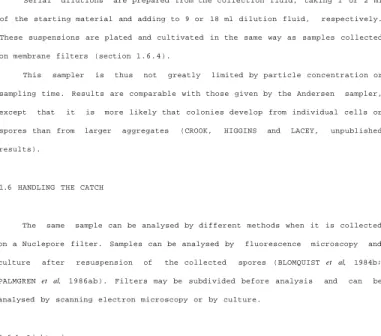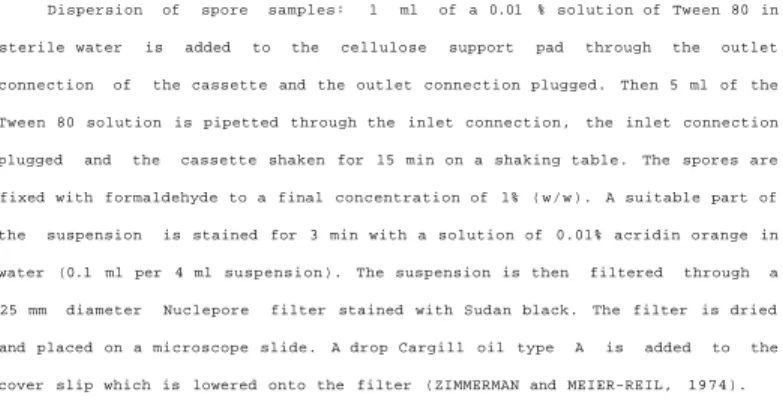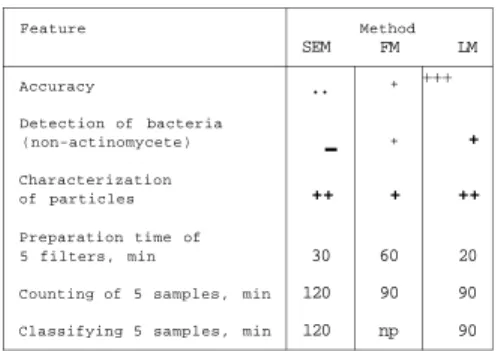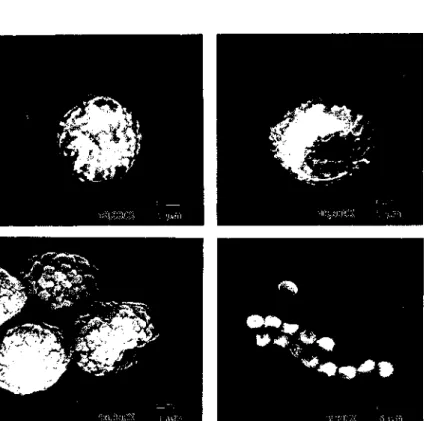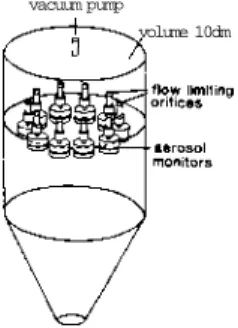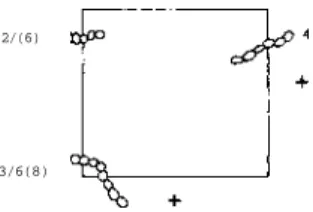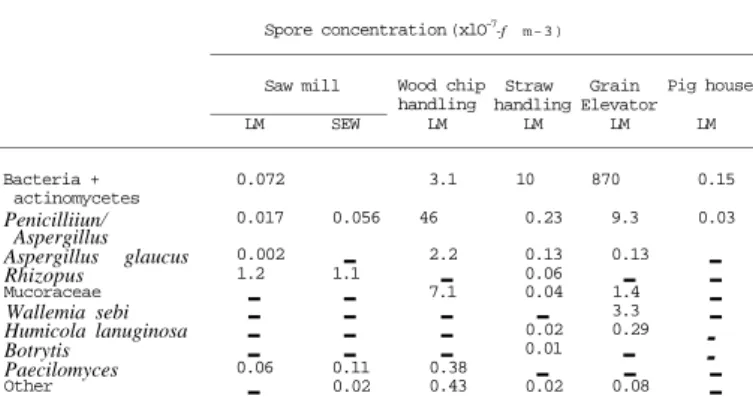The aim of the project was to harmonize the measurement of mold traces by methods based on microscopy. Sampling time can be varied according to the concentration of the airborne microorganisms, with 10 min being satisfactory in concentrations of 108 microorganisms m-3 air. Provided that the deposit is not too heavy, postage of the exposed filter monitors is possible.
The accuracy of the counting of microorganisms by microscopic methods is also affected by the presence of spore aggregates, see also section 1.7.1.2. Single spores or small aggregates of spores can penetrate the upper airways of the lung (trachea and bronchi) or into the non-ciliated peripheral airways and alveoli. The available information is insufficient to make general assumptions about the aerodynamic diameter of track aggregates based on the size and shape of the aggregates and of the individual tracks.
If, as an approximation, the density of a track is assumed to be 1 g cm-3, the aerodynamic diameter of a track corresponds to the physical diameter of the track.
SAMPLING STRATEGY
Rules for selecting the required numbers of workers and samples are given by LEIDEL et al. (1977). Statistical tests should be used to determine the difference between two series assuming a lognormal distribution or no distribution (non-parametric tests) (for example, care should be taken to ensure that the viability of the micro-organisms is not affected when species must be determined.
To obtain a good estimate of the distribution of microorganisms in the work environment, a large number of samples often need to be collected due to the large spatial and temporal variability. Because there are other sources of error in human dose estimation and the majority of trace amounts are present in the. This is advantageous for direct assessment of the filters by light and scanning electron microscopy.
The maximum flow rate is usually limited to 2 l min-1 by the capacity of the battery powered pumps. However, agar or medium homogenization can be used to collect the glycerol and gelatin, dilute and replate as in a slot sampler (BLOMQUIST et al, 1984b). Thus, its main use indoors may be to visually distinguish when large concentrations of dust are produced in the air.
The size fractions correspond to particles that settle in the nose and pharynx, upper airways and alveolar region of the human lung. Samples can be analyzed by fluorescence microscopy and culture after resuspension of the collected spores (BLOMQUIST et al, 1984b; . PALMGREN et al, 1986ab). The choice of agar media and incubation temperatures is wide and must depend on the objectives of the work.
The size distribution of parts of aggregates observed in the field of view can be used for the prediction of the precision. The number of spores in the samples must be calculated by taking into account the location of the field on the filter. The number of spores in the sample is calculated assuming an even distribution of the spores on the filter.
Spore Aggregates are dispersed during resuspension of the spores, and the aggregate size distribution is not valid for the airborne aggregates.
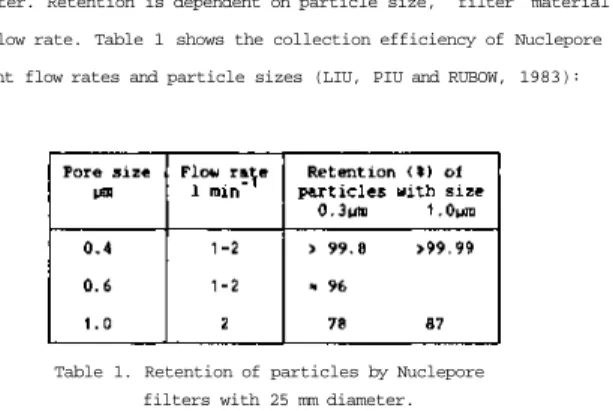
ABSTRACT
INTRODUCTION
Series of ten parallel samples were collected at each of the five sites, normally using closed 37 mm diameter filter holders (Nuclepore), each with a 5 cm extension ring. The inlet velocity of the closed face filter holders was 1 ms -1 and the long extension tube corresponds to the sampling recommendations of the British Health and Safety Executive (Health and Safety Executive, 1984) and was believed to ensure the even distribution of particles on the filter would promote. . The calculated inflow velocity of the sampling device was approximately 5 cm s_1, so particles larger than 40 µm should not have been sampled.
However, the supplied 5 cm extension ring was replaced with a specially prepared 1.3 cm extension ring with an identical shape to that of the standard three-piece non-conductive aerosol monitor. After removing the filters from four sets of duplicate air samples analyzed by AMY, additional clean polycarbonate filters were inserted into the filter holders. Filters were divided into two wells without the midline, and the larger segment was mounted in glycerol triacetate (DARKE et al., 1976) on a standard glass microscope slide and covered with a 26 x 50 mm coverslip.
One square in the center of the field of view was counted in samples with dense deposits of actinomycete spores, but in samples with less dense deposits and for fungal spores, 12 squares were counted in a line perpendicular to the beam. First, 1 ml of the solution was pipetted into the outlet port of the monitor to wet the cellulose support pad. Typically, 40 random fields were counted, giving a total of about 400 microorganisms, but if the deposition density greatly exceeded ten spores per field, fewer fields were counted (PALMGREN et al., 1986; POPENDORF, 1986) .
Approximately 270 fields spaced approximately 1 mm apart in a square grid pattern covering the entire surface of the filter sample were counted. All spores that fell entirely within the field of view were counted, but where spores or aggregates touched the edges of the field of view, only those that touched or crossed the edges on two sides of the field were counted (+, Figure 2) and those that touched or crossed the other two edges (-, Figure 2) were ignored. 2 also shows the methods used to record aggregates that cross the + and - limits of the field of view.
The results of the four runs were pooled for each laboratory to obtain an estimate of precision. EDUARD and AALEN (1988) found that the relative accuracy of total spore counts could be predicted by equation (4.
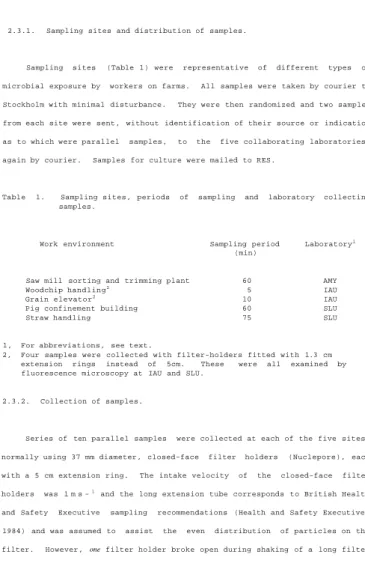
RESULTS AND DISCUSSION
Indeed, single spores in FM preparations constituted 75 - 100% of the total SCU (Table 4), considerably more than by other methods, but this only increased the number of single spores to a level similar to that found in samples for LM and SEM (Table 3), where 40 - 85% of the particles were single spores and even exceeded LM and SEM numbers of single spores with samples taken during straw handling. The precision of the spore count was reduced by LM and SEM with the number of large SCUs present in samples. The samples were exchanged and retold and also one of the samples produced at IAS was retold by W.E.
Fewer airborne spores were found in the pig house and these were mainly bacteria + actinomycetes. Although most particles of each of the 6 fungal pore species recognized by LM consisted of single spores, more than half of the actinomycete + bacteria particles were two-spored or larger, and some exceeded 200 spores in size. Particle size is important because it can affect where the spores deposit in the lungs.
The spores were all in the 20 - 30 mm diameter size and the aggregates were relatively compact. Enumeration of individual colony types confirmed suggestions from LM that there were significant differences in aerial spore species composition between different sites (Table 7. Fewer of the fungal spores counted by LM grew in culture from samples from the pig house (3.1%) and from the treatment of wood chips (7.1%).
The counting precision of the total number of traces could be predicted based on the total size distribution. No attempt was made to predict the counting precision of the samples analyzed in this study due to differences in the number of traces counted, the total size distribution, and in the counting procedure. It was noticed that the filters exposed in the pigsty had a much denser deposit immediately under the inlet port than elsewhere on the filter.
Spore density was greatest near the center of the filters and then decreased towards the edge. There are advantages, in a more even distribution of particles on the filters, to using conductive filter containers instead of the standard non-conductive containers. Estimates of trace concentration varied little (Table 9) and few traces (1.4%) were found on the inner walls of the filter containers indicating that only a small fraction of the filter surface had become detached.
Capture efficiency also depends on the retention of particles by the filter, a function of the filter material, pore size and flow rate.
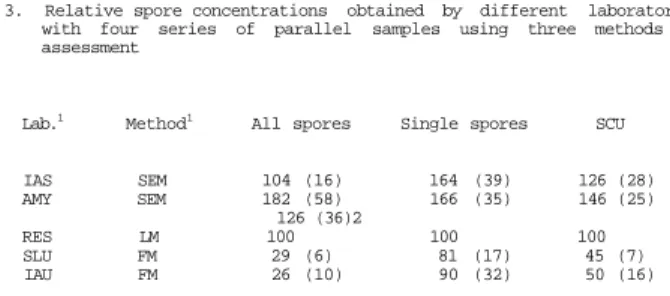
CONCLUSIONS AND RECOMMENDATIONS
Although the collection efficiency increases as the pore size decreases, the flow resistance also increases, resulting in increased current consumption if the same flow rate is to be maintained. The operating time of battery pumps is limited, so a compromise between current consumption and sampling time is necessary. The current consumption of two personal sampling pumps was measured at the ASS to determine the longest period they could operate.
Reducing the pore size of the 25 mm diameter polycarbonate filter from 0.8 to 0.2 mm halved the possible sampling period. It was concluded that a pore size of 0.8 mm or less and a flow rate of at least 1 l min-1 should be used. However, deposition was more uniform when open-sided 25 mm diameter filter holders with 13 mm extension tubes made of conductive, graphite-filled polypropylene were used.
To achieve at least 10% relative counting accuracy, it was necessary to count 150-200 spore-containing particles, or at least 500 spores and actinomycete bacteria and 200-300 fungal pores. The same sampling method could also be used to collect samples for analysis of endotoxins and possibly mycotoxins.
ACKNOWLEDGEMENTS
1986) Comparisons of organic dust exposures in agricultural occupations and waste processing industries Am. 1976) Respiratory disease of workers harvesting wheat. Los Alamos Scientific Laboratory Report No. 1984) Settling rate of spore clusters. 1973) Microbiology of the Atmosphere, 2nd Edition. In Safety In Microbiology (Edited by D.A. Shapton and R.G. Board) (Society of Applied Bacteriology Technical Series No. 6), p. 1983) Characteristics of Air Sampling Filter Media.
Endotoxins in the agricultural environment. of airborne microorganisms on Nuclepore filters: assessment and analysis - CAMNEA method.
